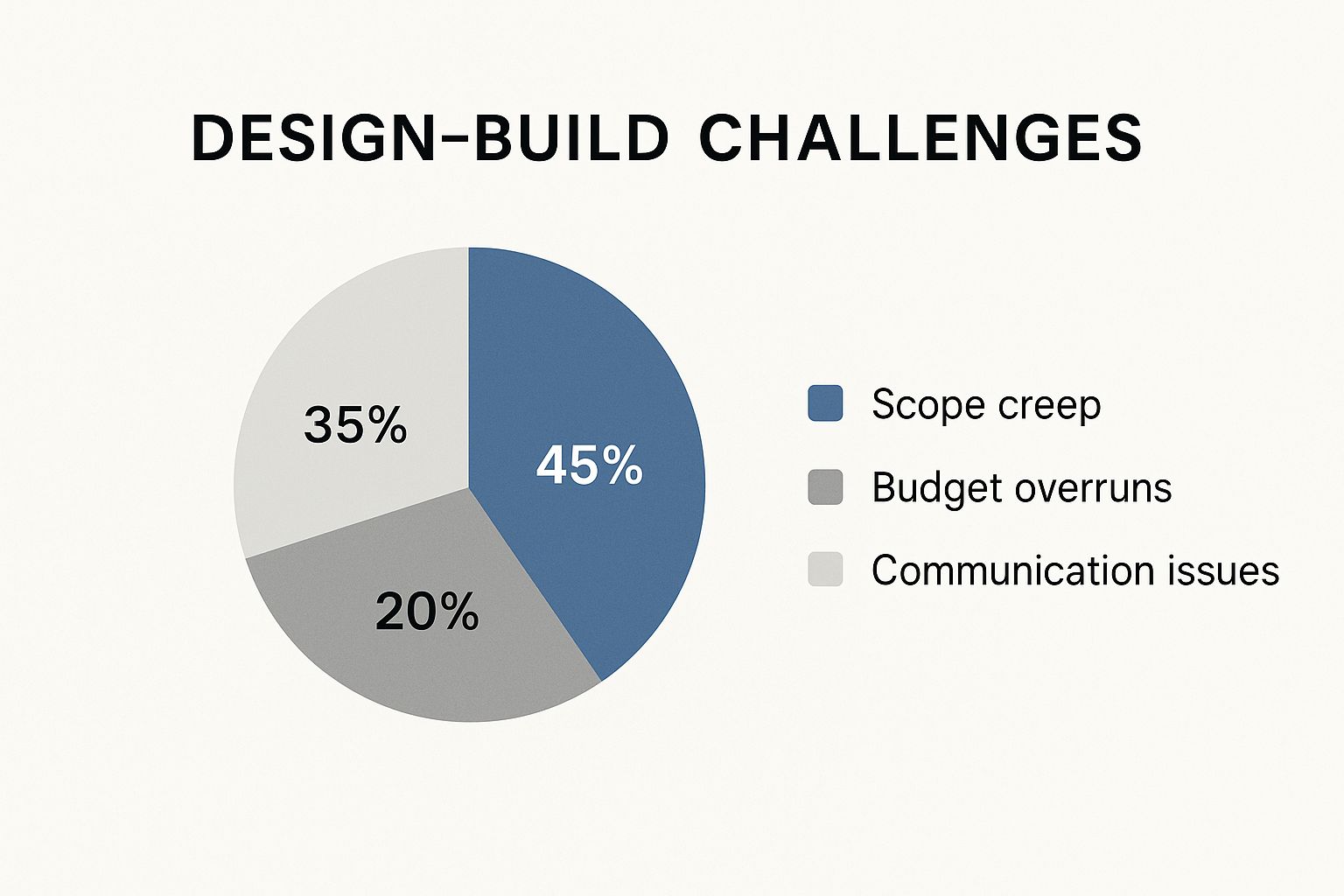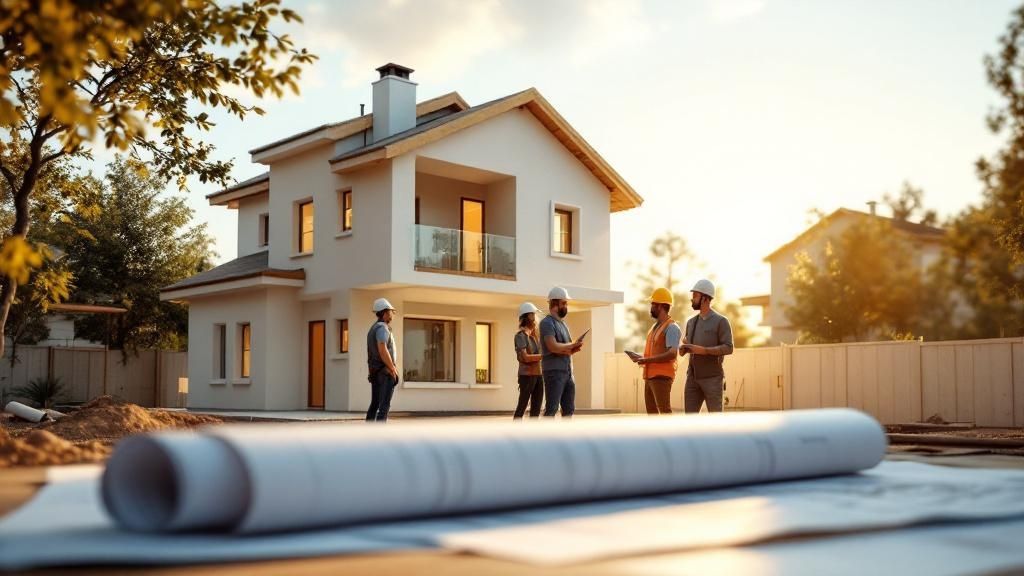Design Build Pros and Cons for Luxury Homes

When you’re about to embark on building a luxury home, one of the biggest decisions you'll make is how it gets built. The choice often comes down to weighing the design–build pros and cons, and at its heart, this is a question of accountability.
The design–build model brings everyone to the same table under a single contract, creating one point of responsibility. Traditional methods, on the other hand, separate the designer from the builder, which can sometimes create friction. Your final decision really hinges on what you value more: the seamless efficiency of a unified team or the distinct checks and balances of a separated approach.
Understanding The Design–Build Model
Before we jump into a side-by-side comparison, it’s worth getting a clear picture of what this integrated model actually looks like in practice.
Traditionally, you’d hire an architect to draw up your plans and then shop those plans around to different builders in a tender process. The design–build model throws that sequence out the window. Instead, it brings your entire project—from the first architectural sketches to the final coat of paint—under the roof of one cohesive team.
The entire structure is built on collaboration from day one. When your design and construction experts are working together from the get-go, it completely changes the dynamic of the project. Communication flows more freely, and potential roadblocks are often spotted and smoothed over long before they can cause delays or budget headaches.
One of the most powerful advantages of this model is getting a handle on your costs much earlier in the piece. A firm like Envy Abode can provide preliminary estimates right from the concept stage, so you know exactly where the build budget is heading, giving you confidence and control.
This early cost insight is a game-changer. It opens the door to "value engineering," where design choices are weighed against their real-world cost and buildability. You still have complete creative control over your home's design, but now it’s enriched with practical construction advice woven in from the very beginning.
To explore this topic further, our guide on design and construction takes a deeper look into different project delivery methods.
Design–Build vs. Traditional Model at a Glance
So, how do these two methods stack up when you put them head-to-head? The table below breaks down the core differences to give you a quick snapshot of what to expect from each approach when building a custom home.
Key Aspect | Design–Build Model | Traditional Model (Design-Bid-Build) |
Accountability | Single point of responsibility (one contract). | Multiple points of responsibility (separate contracts). |
Collaboration | High collaboration between design and build teams from the start. | Lower collaboration; can lead to adversarial relationships. |
Costing | Preliminary estimates are provided during the design phase. | Firm costs are only known after the design is complete and bids are received. |
Timeline | Overlapping phases can shorten the overall project schedule. | Sequential phases often lead to a longer project timeline. |
As you can see, the design–build model prioritises integration and early collaboration, which can lead to a faster, more streamlined process. The traditional method, while offering a different kind of oversight, often extends the timeline by keeping the design and build phases completely separate.
The Pros of a Unified Project Team

When you start weighing up the pros and cons of design-build, one advantage stands head and shoulders above the rest: the power of a single, unified team. This model does away with the traditional, often fractured, relationship between the architect who dreams up your home and the builder who has to figure out how to construct it. Instead, you get one entity, one contract, and one clear point of contact responsible for the entire journey.
This isn't just a minor contractual detail; it fundamentally changes the whole dynamic of the project. That classic blame game that starts when a design proves too difficult or expensive to build? It simply vanishes. Problems get solved collaboratively because everyone shares the same goal—bringing your vision to life, on time and on budget.
Cost Certainty from the Concept Stage
One of the biggest anxieties in a traditional build is not knowing the final cost. Often, designs are drawn up in isolation, and it’s only after months of work and going out to tender that the true construction cost is revealed. The design-build model flips this frustrating process on its head by weaving cost analysis into the project right from the get-go.
With a quality design and build service, you get preliminary costings from the earliest concept stages. This early financial clarity gives you a realistic idea of where your budget is heading long before a single sod of earth is turned. It empowers you to make informed decisions, ensuring your architectural vision and your financial reality stay perfectly aligned.
At Envy Abode, our entire process is built to give you full control. Your vision for the home’s design is our starting point, and our integrated team works to make it a reality within the practical constraints of your budget and timeline, offering real-time feedback along the way.
This proactive approach to budgeting helps avoid the painful and costly redesigns that can derail traditional projects. Instead of just reacting to budget blowouts, the team works together from day one to engineer value directly into the design.
Accelerated Timelines and Faster Problem-Solving
In any building project, time is an invaluable resource. The design-build method can significantly shorten the overall project timeline by overlapping the design and construction phases. While the finer details of the design are still being polished, preliminary site work or materials procurement can already be underway. This alone can shave weeks, sometimes even months, off the schedule.
This overlap is only possible because the team is in constant communication. Potential construction headaches are flagged and sorted out during the design phase, not discovered on-site where they cause expensive delays and frustration. This seamless flow of information leads to:
- Faster Decision-Making: When designers and builders are in the same room, questions get answered in hours, not days.
- Reduced Rework: Constructability is baked in from the start, which means fewer errors and less need for costly on-site changes.
- Streamlined Approvals: A cohesive, well-planned submission from a single firm can often simplify and speed up the council approval process.
Of course, unlocking these benefits hinges on choosing the right team. For a deeper dive into this critical first step, you can read our detailed advice on how to select a builder to ensure your project is in capable hands from the very beginning.
Potential Downsides and How to Navigate Them

While the design–build model offers a refreshingly streamlined path, it's wise to go in with your eyes open. A common worry is the lack of a third-party check. When your designer and builder are one and the same, how do you know quality isn't being sacrificed for convenience?
It's a fair question. But the risk really comes down to who you partner with. A truly reputable firm’s entire business is built on its name and the quality of its finished homes. That reputation is their most powerful incentive to maintain exceptional standards across every single detail, from the first sketch to the final build. A deep portfolio and glowing client testimonials are your best insurance policy.
The Myth of Limited Design Freedom
Another hesitation we sometimes hear is that design–build might curb creative expression. The fear is that the in-house design team will naturally lean towards what's easiest to construct, rather than pushing architectural boundaries. With the right firm, however, the complete opposite is true.
At Envy Abode, we ensure you have full control of how your home is designed. The process is built from the ground up to be deeply collaborative. Your vision is the north star, but it’s sharpened and refined by practical, real-time feedback from the construction team. This doesn't stifle creativity; it anchors it, making sure your most ambitious ideas are not only beautiful but also buildable and financially viable.
The real magic of design–build is in this synergy. When we provide preliminary costings right from the concept stage, you have a clear picture of the budget. This gives you the freedom to explore creative ideas without the lingering fear of designing a home you can't actually afford.
Navigating Market and Council Challenges
No project exists in a vacuum. The construction industry is always influenced by economic shifts and regulatory changes, and the Australian sector has certainly seen its share of ups and downs lately.
As of April 2025, approvals for new dwellings fell by 5.7%, and the value of total residential building dipped 1.3% to $8.91 billion. These numbers paint a picture of a complex landscape, shaped by new regulations and market adjustments. You can find out more about these building and construction statistics and what they mean for the industry.
This is where the design–build model can be a double-edged sword. Its integrated nature can fast-track approvals, but only if the firm is nimble enough to adapt to ever-changing council requirements. To guard against these external risks, partner with a firm that has extensive local experience and a proactive strategy for dealing with council. A team that knows the local planning intricacies inside and out is your best asset for keeping a project on track, no matter what the broader market is doing.
Comparing Cost Control and Timeline Efficiency
When you're weighing up the pros and cons of design–build, the conversation almost always lands on two things: your money and your time. The way a project handles cost control and timeline efficiency can genuinely make or break the experience of building a luxury home. Here, the design–build approach has a distinct advantage, simply because it integrates these factors from day one.
With a construction team on board right from the concept stage, you get preliminary estimates that give you an early, realistic grasp of the budget. This isn't just a back-of-the-napkin guess; it’s an informed projection. It allows for what we call "value engineering" throughout the design process, where ideas are constantly checked for cost and buildability. This ensures your creative vision never gets too far ahead of your financial plan.
This integrated cost feedback is a cornerstone of the design–build model. By knowing exactly where the budget for the build is, you can make confident decisions and avoid the common heartbreak of falling in love with a design that is ultimately too expensive to construct.
It’s a world away from the traditional bid process. In that model, you can spend months working with an architect to create stunning plans, only to have the builder’s quotes come back shockingly high. This often forces painful, costly redesigns, causing huge delays and frustration before a single sod has been turned.
How Design–Build Protects Your Timeline
Time efficiency is another area where the design–build model really shines. Because the design and construction teams are working as one, different phases of the project can overlap. It’s often possible for site preparation and foundation work to get underway while the final interior details are still being decided, creating a much more fluid and accelerated schedule.
Proactive Problem-Solving: Any potential construction issues are spotted and solved during the design phase, not on the building site where they cause expensive delays.
Streamlined Communication: Having a single point of contact means decisions are made faster. There’s no endless back-and-forth between separate architectural and construction firms.
Reduced Rework: When builders give their input during the design stage, the plans are far more accurate, leading to fewer on-site changes and mistakes down the track.
This unified workflow is a direct antidote to the usual project headaches. The infographic below shows that while challenges like budget overruns and scope creep can still happen, a unified team is simply better equipped to manage them.

The data really highlights that managing the project's scope is often the biggest hurdle, which just reinforces the need for clear, collaborative planning from the very beginning.
The Australian market also has its own unique set of conditions. While the local construction market is projected to grow to an incredible USD 523.88 billion by 2030, complex council regulations can really hold up timelines. An experienced design–build firm can navigate these challenges far more effectively—a crucial advantage in our local building environment. You can read more about Australian construction market trends on PR Newswire.
Managing costs effectively is also critical, especially for more complex projects. For a closer look at how budgets are structured, check out our breakdown of the cost to add a second storey, which offers some valuable insights into project financials.
Quality, Control, and Your Personal Touch

When you’re commissioning a luxury home, the final build quality and your personal involvement are everything. The way a project is run directly impacts both, which is why it's a critical factor when weighing up the design-build pros and cons. One of the biggest strengths of the design-build model is how it creates a shared sense of ownership over the final result.
Because one team is responsible for everything from the first sketch to the final handover, the motivation to deliver exceptional quality is baked right in. There’s no finger-pointing between a separate architect and builder if a problem pops up. The whole team shares the accountability, which fosters a powerful, collective drive for excellence and ensures every last detail is up to scratch.
Putting You Firmly in Control
A common worry we hear is whether a unified model means the client loses control. In reality, a truly client-focused design-build firm puts you right at the heart of the process. You have full control of how your home is designed, but with the massive advantage of an integrated team that can respond to your ideas with genuine agility.
Instead of just receiving plans to approve, the process becomes a dynamic, collaborative conversation. Say you want to tweak the layout or swap out a material—the team can instantly weigh up the design, structural, and cost implications together. This fluid feedback loop makes certain your home is a perfect reflection of your vision, not just a string of compromises.
At Envy Abode, we provide preliminary estimates right from the concept stage. This transparency means you know exactly where the build budget stands, empowering you to make creative choices with complete financial confidence.
This collaborative approach is also much better at adapting to new industry methods. Digital tools like Building Information Modelling (BIM) are becoming more common in Australia's construction sector, which is forecast to hit USD 356.21 billion by the end of 2025. While BIM can deliver incredible accuracy, it requires an upfront investment. A design-build firm can manage this integration far more smoothly, weighing the pros and cons for your specific project. You can explore more on these Australian construction market insights to see how technology is shaping the industry.
A Simpler, More Personal Journey
At the end of the day, the design-build model simplifies communication without taking away your authority. Having a single point of contact prevents the misinterpretations and delays that can plague traditional projects, keeping things moving smoothly. This lets you focus on the exciting parts of creating your dream home.
For those who love the creative side of things, our guide to custom home design offers more inspiration on developing a truly unique vision for your property. The goal is to make the journey as rewarding as the final result—a home that's not only built to the highest quality but is also deeply and uniquely yours.
So, how do you decide if design-build is the right path for your luxury home? After weighing everything up, the answer really comes down to what you value most in the building journey. This isn't just about signing a different type of contract; it’s a completely different way of thinking about a project, built from the ground up on collaboration, efficiency, and a single source of responsibility.
The decision often boils down to how much you prioritise a simplified, less confrontational process. If having a single point of contact, a faster timeline, and a clear handle on the budget from day one are at the top of your list, then the design-build approach is incredibly appealing. It truly shines on complex, custom projects where inspired design and practical construction need to be in constant conversation to get things just right.
A Final Checklist for Your Decision
To bring it all together, ask yourself these simple questions. Your answers will shed light on which model best suits your vision for building a new home.
- How critical is sticking to a timeline? If you’re working towards a firm move-in date, the overlapping phases of design-build give it a huge scheduling advantage over the one-step-at-a-time nature of traditional methods.
- How comfortable are you with budget uncertainty? The design-build model gives you realistic cost estimates right from the concept stage, offering financial clarity much earlier. If the thought of finalising a design only to find out it blows your budget is a major concern, this is a massive plus.
- How much do you value a collaborative spirit? A unified team completely removes the finger-pointing that can happen between separate designers and builders. If you want a team genuinely working together toward the same goal, design-build is the obvious choice.
Choosing a firm like Envy Abode means you get the best of both worlds. You keep full control over your home's design, but you also gain from exceptional design and build services that ensure your vision is brought to life with quality craftsmanship and total financial transparency.
- At the end of the day, the best choice is the one that gives you the most confidence and peace of mind. Think about the complexity of your dream home, your desire for a hands-on yet smooth experience, and just how important cost control is to you.
- The design-build model is at its best when these factors are your top priorities. It offers a clear, cohesive, and efficient path to creating a luxury home that not only meets but surpasses your expectations. By understanding these key differences, you're in a much better position to choose the building model that will bring your unique vision to life—making the journey just as rewarding as the final home.
Common Questions About Design-Build
Navigating the world of home construction can feel overwhelming, and it's natural to have questions. To help clear things up, we've answered some of the most common queries we hear about the pros and cons of the design-build approach.
Is the Design-Build Method More Expensive?
This is a very common concern, but the short answer is no. While it's true the single contract might seem larger upfront because it bundles both design and construction fees, the design-build model almost always delivers better value for money in the long run.
The magic happens during the design phase. Because everyone is part of the same team, you get real-time cost feedback as the plans develop. This means we can actively "value engineer" the project, making smart adjustments to ensure the design aligns perfectly with your budget from day one.
This proactive approach stops the all-too-common scenario where a finished design goes out to tender only to come back way over budget, forcing costly and frustrating redesigns. Plus, a shorter, more efficient project timeline often leads to real savings on financing costs and minimises your exposure to rising material prices.
Will I Have Less Design Control with a Design-Build Firm?
This is one of the most stubborn myths out there, but with a client-focused firm, it couldn't be further from the truth. In reality, you have full control of how your home is designed. The process is structured to be deeply collaborative, not restrictive.
Your vision is, and always will be, the driving force behind the entire project. The real advantage is that your ideas get immediate, expert feedback on their structural and financial feasibility from a single, unified team.
Think of it this way: if you suggest a specific architectural feature, the in-house builders can instantly confirm if it’s practical and what it will cost. This allows you to make a fully informed decision on the spot, rather than waiting weeks for an outside opinion. It ensures the final home is a true reflection of your personal taste, anchored in practical reality.
How Is Quality Control Handled in a Design-Build Project?
In a design-build project, quality control isn’t just a final check—it’s a continuous, shared responsibility. The common issue of finger-pointing between separate designers and builders simply vanishes because a single company is accountable for the entire project, from the first sketch to the final handover.
This single point of accountability creates a powerful, built-in incentive for everyone to uphold the highest quality standards. Any reputable firm will have strict internal review processes at every stage of the build.
From selecting the right materials to perfecting the finishing touches, the team’s reputation is on the line. This shared ownership creates a culture of excellence that you can see and feel in the final result.
What Type of Project Is Best Suited for Design-Build?
The design-build model really shines on projects where collaboration, budget certainty, and an efficient schedule are top priorities. It’s particularly effective for complex, custom luxury homes that demand tight coordination between creative architectural vision and practical construction execution.
This approach is also perfect for homeowners who prefer a streamlined process with a single point of contact and want to sidestep any potential conflict between separate contractors. If you have a firm deadline or your project involves clever solutions to unique site challenges, you'll benefit immensely from this integrated method. It offers a smoother, more cohesive path to achieving an exceptional home.
Are you ready to experience a building process defined by clarity, collaboration, and quality? Envy Abode provides exceptional design and build services, giving you full control over your home's design with budget transparency from the very beginning. Visit us at https://envyabode.com.au to start your journey.